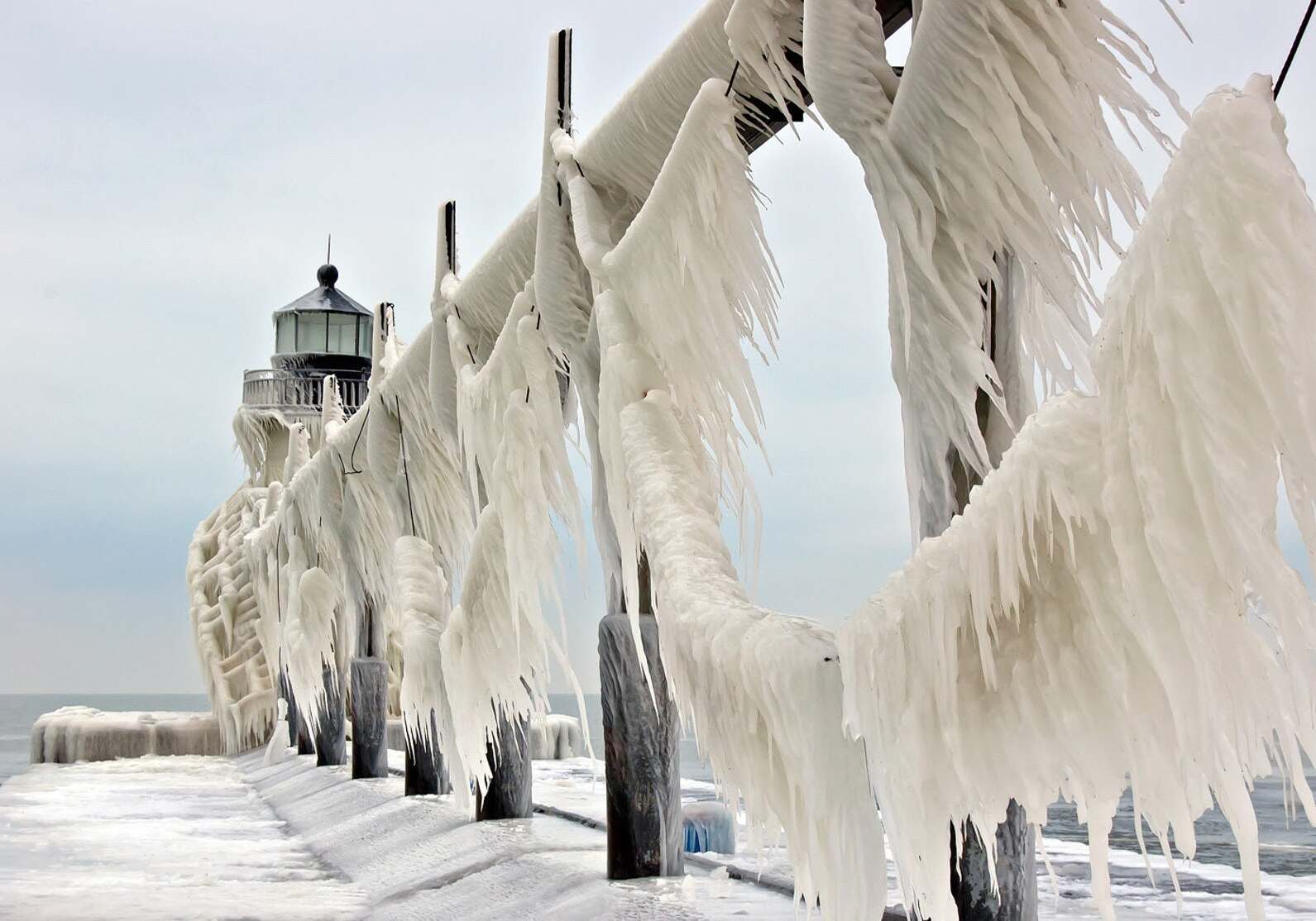
Frozen lighthouses are a mesmerizing sight, blending the beauty of nature with human ingenuity. Ever wondered how these towering beacons of light transform into icy sculptures? Lighthouses near large bodies of water, especially in colder regions, face the brunt of winter's fury. As waves crash and temperatures plummet, layers of ice form, creating stunning, otherworldly structures. These frozen giants not only guide ships but also captivate photographers and adventurers. From the Great Lakes to the Baltic Sea, each frozen lighthouse tells a unique story of resilience and beauty. Ready to dive into some amazing facts about these icy marvels? Let's get started!
Key Takeaways:
- Frozen lighthouses are stunning icy masterpieces formed by freezing temperatures and strong winds. They hold historical significance and attract visitors worldwide with their unique beauty.
- Despite facing challenges, frozen lighthouses provide incredible photographic opportunities, inspire artists, and create a magical winter wonderland. Preservation efforts ensure their beauty and historical significance for future generations.
Frozen Lighthouses: Nature's Icy Masterpieces
Frozen lighthouses are a stunning sight to behold. These towering structures, often covered in thick layers of ice, stand as testaments to the power and beauty of nature. Here are some fascinating facts about these icy beacons.
-
Lake Michigan's Frozen Lighthouses
During winter, Lake Michigan's lighthouses become encased in ice, creating surreal, otherworldly scenes. The combination of freezing temperatures and strong winds causes waves to splash against the structures, freezing almost instantly. -
St. Joseph Lighthouse
The St. Joseph Lighthouse in Michigan is one of the most photographed frozen lighthouses. Its unique ice formations attract photographers and tourists from around the world. -
Ice Thickness
The ice on these lighthouses can be several inches thick. This thick layer of ice can add significant weight to the structure, sometimes causing damage. -
Formation Process
Ice forms on lighthouses through a process called "ice accretion." This occurs when water droplets freeze upon contact with the cold surface of the lighthouse. -
Wind's Role
Strong winds play a crucial role in the formation of ice on lighthouses. They drive waves against the structures, causing water to splash and freeze. -
Temperature Requirements
For a lighthouse to become completely encased in ice, temperatures must remain below freezing for an extended period. This ensures that the ice continues to build up without melting.
Historical Significance of Frozen Lighthouses
Frozen lighthouses are not just beautiful; they also hold historical significance. Many of these structures have been guiding ships for over a century.
-
Built in the 19th Century
Many of the lighthouses that freeze over in winter were built in the 19th century. They have withstood the test of time and harsh weather conditions. -
Guiding Ships
Despite being covered in ice, these lighthouses continue to serve their primary purpose: guiding ships safely through treacherous waters. -
Architectural Marvels
The design and construction of these lighthouses are architectural marvels. They were built to withstand the harshest weather conditions, including freezing temperatures and strong winds. -
Historical Landmarks
Many frozen lighthouses are designated historical landmarks. They are preserved for their historical and cultural significance.
The Science Behind Frozen Lighthouses
Understanding the science behind frozen lighthouses can make these icy structures even more fascinating.
-
Ice Accretion Explained
Ice accretion occurs when supercooled water droplets freeze upon contact with a surface. This process is responsible for the thick layers of ice on lighthouses. -
Supercooled Water Droplets
Supercooled water droplets are water droplets that remain liquid even at temperatures below freezing. When they come into contact with a cold surface, they freeze instantly. -
Role of Humidity
High humidity levels can contribute to the formation of ice on lighthouses. Moisture in the air can freeze upon contact with the cold surface of the lighthouse. -
Impact of Wind Chill
Wind chill can significantly lower the temperature around a lighthouse, making it easier for ice to form. The stronger the wind, the faster the ice builds up. -
Thermal Conductivity
The materials used to build lighthouses, such as metal and concrete, have high thermal conductivity. This means they can quickly transfer heat, allowing ice to form more rapidly.
Famous Frozen Lighthouses Around the World
Several lighthouses around the world are known for their stunning ice formations. These frozen lighthouses attract visitors and photographers alike.
-
Michigan City Lighthouse
Located in Indiana, the Michigan City Lighthouse is famous for its dramatic ice formations during winter. The lighthouse becomes a frozen wonderland, drawing crowds of visitors. -
Grand Haven Lighthouse
The Grand Haven Lighthouse in Michigan is another popular spot for viewing frozen lighthouses. Its picturesque ice formations make it a favorite among photographers. -
South Haven Lighthouse
The South Haven Lighthouse, also in Michigan, is known for its beautiful ice-covered appearance during the winter months. The lighthouse becomes a stunning ice sculpture. -
Point Betsie Lighthouse
Point Betsie Lighthouse in Michigan is renowned for its breathtaking ice formations. The lighthouse, covered in thick layers of ice, looks like a scene from a winter fairy tale. -
Marquette Harbor Lighthouse
The Marquette Harbor Lighthouse in Michigan is another iconic frozen lighthouse. Its striking ice formations make it a must-see during the winter season.
Challenges Faced by Frozen Lighthouses
While frozen lighthouses are beautiful, they also face several challenges due to the harsh winter conditions.
-
Structural Damage
The weight of the ice can cause structural damage to lighthouses. The thick layers of ice can put immense pressure on the structure, leading to cracks and other damage. -
Accessibility Issues
Frozen lighthouses can be difficult to access during winter. The ice and snow can make it challenging for maintenance crews to reach the lighthouse. -
Maintenance Challenges
Maintaining a frozen lighthouse is no easy task. The ice can make it difficult to perform routine maintenance and repairs. -
Safety Concerns
The ice on lighthouses can pose safety risks. The slippery surface can make it dangerous for anyone trying to access the lighthouse. -
Weather Conditions
Harsh winter weather conditions can make it challenging to monitor and maintain frozen lighthouses. Snowstorms, high winds, and freezing temperatures can all impact the lighthouse.
The Beauty of Frozen Lighthouses
Despite the challenges, frozen lighthouses remain a breathtaking sight. Their beauty captivates people from all over the world.
-
Photographic Opportunities
Frozen lighthouses provide incredible photographic opportunities. The unique ice formations and stunning winter landscapes make for perfect photo subjects. -
Tourist Attractions
Many frozen lighthouses have become popular tourist attractions. Visitors flock to these icy structures to witness their beauty firsthand. -
Inspiration for Artists
The beauty of frozen lighthouses has inspired many artists. Painters, photographers, and writers have all been captivated by these stunning structures. -
Winter Wonderland
Frozen lighthouses create a magical winter wonderland. The combination of ice, snow, and the lighthouse itself creates a scene straight out of a fairy tale. -
Natural Ice Sculptures
The ice formations on lighthouses can look like natural ice sculptures. The intricate patterns and shapes created by the ice are truly mesmerizing.
Preservation Efforts for Frozen Lighthouses
Preserving frozen lighthouses is important to ensure their beauty and historical significance are maintained for future generations.
-
Restoration Projects
Many frozen lighthouses undergo restoration projects to repair any damage caused by the ice. These projects help preserve the structural integrity of the lighthouse. -
Historical Societies
Historical societies play a crucial role in preserving frozen lighthouses. They work to maintain and protect these important landmarks. -
Government Funding
Government funding is often used to support the preservation of frozen lighthouses. This funding helps cover the costs of maintenance and restoration. -
Community Involvement
Local communities often get involved in the preservation of frozen lighthouses. Volunteers help with maintenance and restoration efforts. -
Educational Programs
Educational programs are used to raise awareness about the importance of preserving frozen lighthouses. These programs teach people about the history and significance of these structures.
Fun Facts About Frozen Lighthouses
Here are some fun and interesting facts about frozen lighthouses that you might not know.
-
Ice Colors
The ice on lighthouses can appear in different colors. Depending on the light and the thickness of the ice, it can look blue, white, or even green. -
Sound of Ice
When the ice on a lighthouse cracks or shifts, it can create eerie sounds. These sounds can be quite loud and add to the mystical atmosphere of the frozen lighthouse. -
Ice Patterns
The patterns formed by the ice on lighthouses are unique. No two frozen lighthouses look exactly the same, making each one a unique work of art.
Frozen Lighthouses: Nature's Icy Marvels
Frozen lighthouses are more than just stunning visuals; they’re a testament to nature's power. These icy structures form when frigid winds and waves coat lighthouses in layers of ice, creating breathtaking scenes. They remind us of the harsh conditions sailors face and the resilience of these guiding beacons.
Visiting one of these frozen wonders offers a unique experience, blending history, nature, and sheer beauty. Whether you're a photographer, history buff, or just someone who loves nature, frozen lighthouses provide a rare glimpse into the intersection of human engineering and natural forces.
Next time winter rolls around, consider seeking out one of these icy marvels. You’ll not only witness a rare phenomenon but also gain a deeper appreciation for the enduring strength of lighthouses and the relentless beauty of winter.
Frequently Asked Questions
Was this page helpful?
Our commitment to delivering trustworthy and engaging content is at the heart of what we do. Each fact on our site is contributed by real users like you, bringing a wealth of diverse insights and information. To ensure the highest standards of accuracy and reliability, our dedicated editors meticulously review each submission. This process guarantees that the facts we share are not only fascinating but also credible. Trust in our commitment to quality and authenticity as you explore and learn with us.


